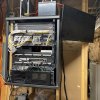I use Cat6 Riser shielded blue cable for my cameras. The cable is stiff, and I got 8 of those coming into a cabinet (or say enclosure) where the NVR is. After all the cables are in the PoE ports, it requires force to push the NVR back to be able to shut the enclosure door. Somebody said that I use patch panel to help ease the strain on ports and connectors. Do you concur with the idea?
I am thinking that if I do use patch panel, it will still need to be connected to the NVR but not sure if it will stay outside or inside the enclosure.
To give you an idea, my enclosure looks like the attached. Mine just doesn't have the side door, it only has the front glass door with metal frame.
I am thinking that if I do use patch panel, it will still need to be connected to the NVR but not sure if it will stay outside or inside the enclosure.
To give you an idea, my enclosure looks like the attached. Mine just doesn't have the side door, it only has the front glass door with metal frame.




